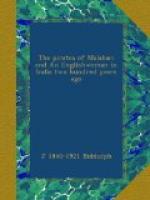In the East Indies nothing of the kind was possible. The acquisition of land for agriculture was out of the question. Trade was the only opening, and that was monopolized by the Company. Except as a servant of the Company, an Englishman had no legal status in the East. The chief profits went to the shareholders in London. If at the end of twenty-five years or so a Company’s servant could return to England with a few thousands made by private trade, he was a fortunate man. Private traders and a few of the governors were alone able to make fortunes. The shaking of the pagoda tree did not begin till after Plassey. The result was that the men who went to India were of a totally different class from those who went to America and the West Indies; they were young men from small trading families in London, Greenwich, and Deptford, or from seaport towns like Bristol and Plymouth. Among them were some restless and adventurous spirits who found life in England too tame or too burdensome. For such men India was long regarded as a useful outlet. “If you cannot devise expedients to send contributions, or procure credit, all is lost, and I must go to the Indies,” wrote William the Third, in bitter humour, at a desperate crisis in his affairs. Fryer tells us (1698) how the Company had entertained Bluecoat boys as apprentices for seven years, after which time they were to be made writers, if able to furnish the required security. The salaries they received from the Company were only nominal. A Bombay pay-list of January, 1716, shows us the official salaries at that time. The Governor received L300 per annum. Next to him came eight merchants, who with him constituted the Council, and received respectively, one L100, one L70, two L50, and four L40 each. Below them came three senior factors at L30 each, three junior factors at L15, and seven writers at L5.[1] The tale is completed by the accountant and the chaplain, who received L100 each. A writer on entering the service had to find security for L500, which was increased to L1000 when he rose to be a factor. The unmarried servants of the Company were lodged at the Company’s expense; the married ones received a lodging allowance, and a public table was maintained. In fact, the Company treated them as if they were apprentices in a warehouse in St. Paul’s Churchyard, and, when the conditions of their service are taken into account, it is not surprising that there was a considerable amount of dishonesty among them. These conditions apart, they were neither worse nor better than the men of their time. As the original Company gained stability by the incorporation of its upstart rival established in 1698,[2] which put an end to a condition of affairs that promised to be ruinous to both, and by the grant of perpetuity issued in the year following incorporation, there was a gradual improvement in the quality of their civil servants. Though no increase in the salaries of junior officers took place for many years afterwards, the greater facilities opened to them, for trade, attracted better men into the service, among them some cadets of good family.




